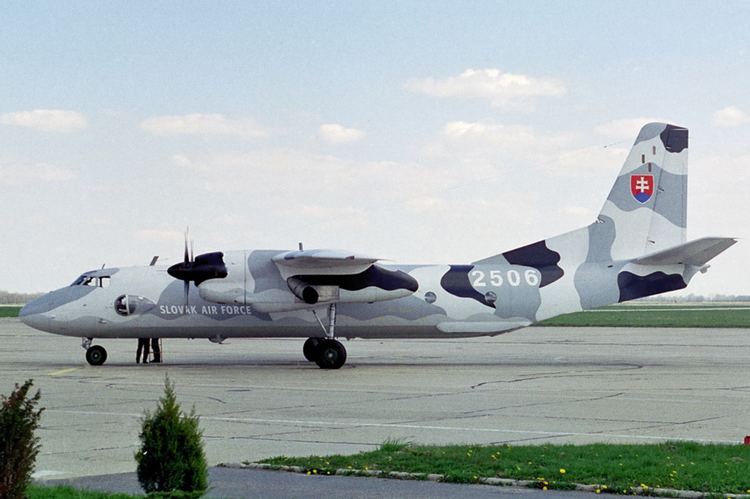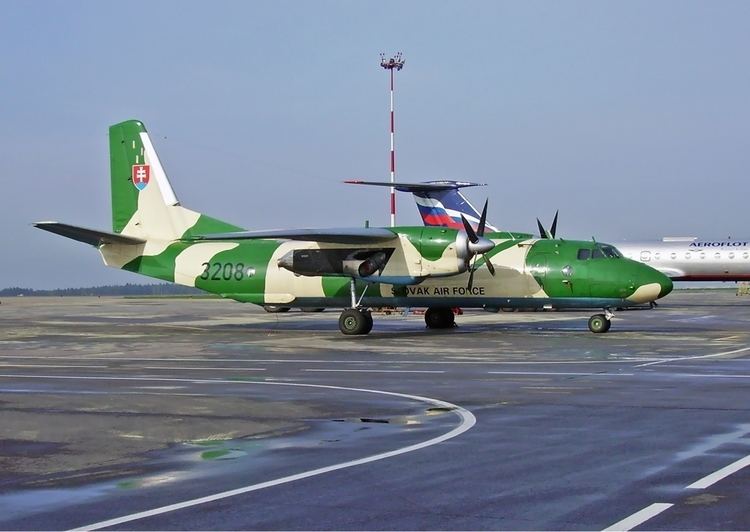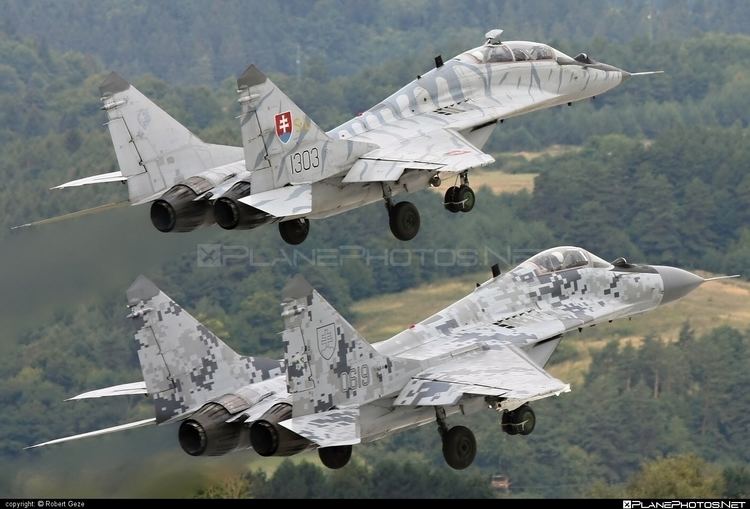Active 1939-19451993-2017 Fighter Mikoyan MiG-29 Trainer Aero L-39 Albatros | Founded 1993 Attack aircraft Aero L-39 Albatros | |
 | ||
Size 25 aircraft9 helicopters3.200 personnel Air Force Commander Major General Miroslav Korba Similar Czech Air Force, Hungarian Air Force, Ground Forces of the Slova, Romanian Air Force, Bulgarian Air Force | ||
Rehearsal slovak air force mig 29 luchtmachtdagen gilze rijen 19 06 2014
The Slovak Air Force, known since 2002 as the Air Force of the Armed Forces of the Slovak Republic (Slovak: Vzdušné Sily Ozbrojených Síl Slovenskej Republiky), is the aviation and air defense branch of the Slovak Armed Forces. It operates 25 aircraft and 9 helicopters from 3 air bases: Malacky Air Base, Sliac Air Base, Prešov Air Base. Together with the Czech Air Force, it succeeded the Czechoslovak Air Force in 1993. The Slovak Air Force is part of the NATO Integrated Air and Missiles Defense System – NATINADS.
Contents
- Rehearsal slovak air force mig 29 luchtmachtdagen gilze rijen 19 06 2014
- Modernized slovak air forces
- 19391945
- 19461992
- 19932017
- Bases and Commands
- Retired aircraft
- References

The Slovak Air Force is tasked with the defense of the sovereign Slovak state and the support of the nation's ground troops. Ten Russian upgraded fighter aircraft MiG-29 together with seven modernized basic and light advanced trainers (Aero L-39) dominate the inventory, followed by the seven Let L-410s. The last Antonov An-26 transport aircraft were withdrawn from service on March 4, 2016. The helicopter fleet consists of the nine Mil Mi-17s. The Slovak Air Force has been under the command of Major General Miroslav Korba since September 15, 2012.
Modernized slovak air forces
1939–1945

After the division of Czechoslovakia by Nazi Germany in 1939, Slovakia was left with a small air force composed primarily of Czechoslovak combat aircraft. This force defended Slovakia against Hungary in 1939, and took part in the invasion of Poland in support of Germany. During the World War II, the Slovak Air force was charged with the defense of Slovak airspace, and, after the invasion of Russia, provided air cover for Slovak forces fighting against the Soviet Union on the Eastern Front. While engaged on the Eastern Front, Slovakia’s obsolete biplanes were replaced with German combat aircraft, including the Messerschmitt Bf 109. The air force was sent back to Slovakia after combat fatigue and desertion had reduced the pilots' effectiveness. Slovak air units took part in the Slovak National Uprising against Germany from late August 1944.
1946–1992

During this time Czechoslovakia was a member of the Eastern Bloc, allied with the Soviet Union, and from 1955 a member of the Warsaw Pact. Because of this, the Czechoslovak Air Force used Soviet aircraft, doctrines, and tactics. The types of aircraft were mostly MiGs. MiG-15, MiG-19, and MiG-21F fighters was produced in license; in the 1970s, MiG-23MF were bought, accompanied by MiG-23ML and MiG-29s in the 1980s.
During the 1980s and early 1990s, the Czechoslovak Air Force consisted of the 7th Air Army, which had air defense duties, and the 10th Air Army, responsible for ground forces support. The 7th Air Army had two air divisions and three fighter regiments, and the 10th Air Army had two air divisions and a total of six regiments of fighters and attack aircraft. There were also two reconnaissance regiments, two transport regiments, three training regiments, and two helicopter regiments.
In November 1989 Communism fell across Czechoslovakia. The two parliaments of the two new states from 1993, the Czech Republic and Slovakia, decided how to split the assets of the former air force. The assets were divided 2:1 in the Czechs' favor, and thus the Slovak Air Force was (re)formed. However the 20 MiG 29s were shared equally between the two countries.
1993–2017
After the formal dissolution of Czechoslovakia on January 1, 1993, Czech and Slovak aircraft were divided according to each nation's population, in a ratio of nearly 2:1 in the Czech Republic's favor. The exceptions to this rule were the MiG-23's, which were given exclusively to the Czech Air force, and the MiG-29's, which were divided evenly between the two nations. Slovak bases were initially under-equipped to handle the aircraft transferred from the Czech bases, and required considerable improvements in infrastructure to facilitate the new air force. On March 1, 1995, the air force replaced the Soviet style aviation regiment organization with the western wing and squadron system. Around 2000–2002, Slovakia gradually retired many of the older aircraft, including the entire fleet of Su-22, Su-25, and MiG-21. In 2004, the flight training academy and national aerobatic demonstration team Biele Albatrosy, both based at Košice, were disbanded.
On January 19, 2006, the Slovak Air Force lost an Antonov An-24 in a crash.
On September 20, 2011, all of the remaining Mil Mi-24 gunships were retired.
In January 2014, Slovakia started discussions with the Swedish Government regarding leasing or purchasing JAS-39 Gripen aircraft to replace their MiG-29 fighters.
On April 21, 2014 Slovakia and RAC MiG signed a contract for a three years long modernization programme for the air force's MiG-29 fighters.
On July 28, 2014 Slovak Minister of Defence Martin Glváč confirmed that the JAS-39 Gripen was selected as the new fighter aircraft for the Slovak Air Force.
Slovakia to open talks with Sweden on Gripen jet fighters. In its effort to boost defence capabilities, Slovakia is set to begin official talks on the rental of Gripen jet fighters from Sweden, with the Slovak government assigning the task to Defence Minister Martin Glváč at its regular session on March 18, 2015. Glváč envisaged the beginning of the negotiations back in late January. The government maintains, as quoted by the TASR newswire, that Sweden is the only country to offer Slovakia an option whereby it could rent flying hours. Details of the costs and number of Gripens to be used in Slovakia are still to be elaborated during the talks.
“The only partner who fulfils our current conditions is the Swedish government, and the producer of Gripens,” he said.
After two years of talks with Sweden about acquiring Gripens, Slovakia is now pursuing other options regarding its fighter squadrons and is in talks with Russia to extend its use of MiG-29 fighters by 2019.
Bases and Commands
Retired aircraft
Previous aircraft operated by the Air Force include MiG-21’s, Sukhoi Su-22’s, Sukhoi Su-25’s, Tupolev Tu-154’s, Aero L-29’s, Mil Mi-24 helicopters, Antonov An-24 and Antonov An-26
